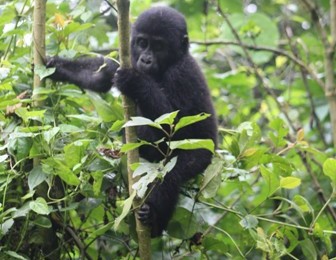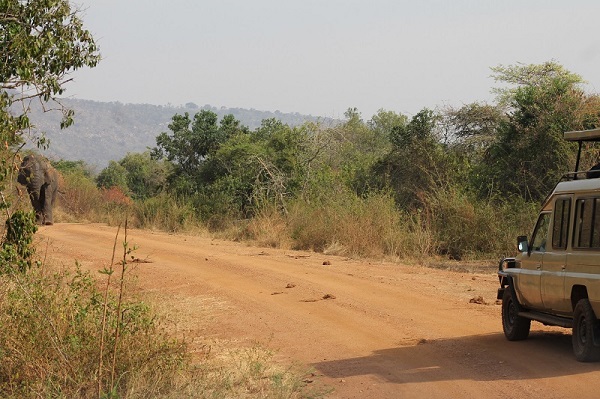Murchison Falls National Park is Uganda’s biggest park. It is also the most popular park in Uganda for wildlife safaris because it offers the best chances to see most of the animals, and the thrilling boat cruise experience on the River Nile leading to spectacular views of the famous Murchison Falls – the world’s strongest waterfalls! The park is also easy to access with a good paved road from Kampala going all the way into the park (takes 5 – 6 hours drive).
The excellent safari experience and easy access make Murchison Falls National Park the destination of choice for most safari trips, attracting more independent travelers on self-drive trips! But, as more people opt for self-drive safari trips to the Murchison Falls National Park, incidences of fatal animal attacks and accidents are on the rise in the park. This is largely because travelers do not how to conduct themselves during safari in Murchison Falls National Park.
In this article I share tips on how to keep safe while in the park and also highlight animals and other wildlife that pose the biggest threat or danger to you while on safari that you need to be careful about.
1. Do not go off the game drive track!
This is perhaps one of the biggest causes of animal accidents in the park. Tourists are tempted to get off the drive track to get closer and get clear views of a prized animal (such as lion) that is far away from the track or is hidden behind a bush. However, you may be ambushed and cornered by another aggressive animal (such as elephant or buffalo) and it would be difficult for you to escape because of bushes in the way. The car may also get stuck in the bush tempting you to get out of the car and putting your life in danger.
2. Do not drive beyond 40km/hr
The legal speed limit anywhere in the park is 40km/hr and driving beyond that is over speeding that will put you at a risk of colliding with a large animal such as an elephant, giraffe, hippo and buffalo, the result of which is fatal. Driving beyond the speed limit also puts other smaller animals at risk and killing an animal attracts a heavy penalty.
3. Do not hoot in the park
Hooting in the park is illegal and can be risky for you as some animals are put off by noise. An agitated elephant can charge at you if it relates the sound of the hooting with a threat. Hooting will also scare other wildlife spoiling the safari experience for you and other visitors in the park.
4. Respect the 10 meter rule
It is advised the closest you should get to an animal should be not less than 10 meters. But this also depends on the behavior of the animal at that particular time. If you notice a large animal such as an elephant or buffalo is agitated, please keep far away from it. You should also not attempt to get closer to animals with babies.
5. Do not feed the animals or eat near animals
Tourists are tempted to throw a banana or biscuit to a monkey, baboon or even elephant, but this is not advised because this causes the animals to lose their natural instinct of looking for food in the bush and in the end, they start invading people and grabbing food causing injury in the process. There are incidents when baboons have ripped faces of tourists in an attempt to grab food.
6. Do not leave the car door or hotel room open.
Scavenging animals like monkeys, baboons, warthogs are always in the vicinity looking for an opening for some free goodies. Elephants also sniff around for bananas and fruits. The most dangerous perhaps are the snakes that can easily crawl into the room without being noticed.
7. Put on a life jacket during the boat safari on the Nile.
However good a swimmer you may be, the fast-flowing waters of the Nile may be too much for you in case of a boat accident. In the last decade only one tragic incident of a boat accident has been recorded in Murchison Falls National Park, and it is remembered only those that had life jackets on survived.
8. Wear nature blending colors such as greens and browns.
Avoid bright colors. For instance, color red is seen as blood by predators and can attract an attack, while for some other animals and wildlife such as birds it signifies danger and will scare them away.
9. Do not get out of the car during safari drive in the park
Do not get out of the car except in designated places but still be on the lookout for which animals are nearby, and look where you step. Also do not wonder too far from the car.
10. Do not smoke in the park, you can easily start a fire
11. Take a professional tour guide/driver
If you can, hire a professional tour guide/driver. A professional tour guide/driver has undergone intense training about animal behavior and will know what to do in case faced with a difficult situation from an aggressive animal.
12. Take an armed park ranger/guide for the safari drive
Park rangers/guides are available in the park for hire. The park guide knows well about animal behavior and will guide on how to approach particular animals. The ranger guide also knows the best places to find certain animals of interest that will help you avoid unnecessary drive in the park that can lead you into dangerous situations.
13. Be care while at the Top of the Murchison falls
Avoid getting closer to the wet rocks and the raging water. The temptation to get a perfect selfie or video has led travelers slipping into the falls or being swept away by a gush of water!
Dangerous animals & wildlife to watch out for in Murchison Falls National Park
1. Elephants
Watch out for herds with babies. Elephants are very protective of their babies and if you aggressively get too close they will charge at you. Lone elderly elephant bulls that have been pushed out of their herds are very frustrated and easily charge when approached. But thankfully, unlike most animals, elephants will warn before attacking to give you a chance to leave. Look out for the aggressive flapping of ears as the initial sign.
2. Buffaloes
Buffaloes are sadist killers; they do not need a reason to bump you off! They are also good at ambushing from cover so never leave the car when near a bush. The most dangerous buffaloes are the lone males that have been pushed out of the herds. They are very frustrated and will look for any opportunity to vent their rage and humans are a soft target
3. Hippos
The number one killer in Africa! As long as you get close it will simply cut you into pieces with its big teeth. Thankfully they spend the hot day in water and mud pools and only come out to graze in the evening/night when the temperatures drop. Always be on the look out when walking around in the night, or do not move at all.
4. Leopard
A very stealth predator that is missed most of the time on safari. They are also quite shy and will not allow you get close before they disappear into the bushes. However, it is the most dangerous animal when it has babies (cubs)! If you ever notice a leopard with cubs, do not dare leave the car or get close. The leopard does not go for any other body part apart from the neck!
5. Lion
The king of the jungle has a reputation of being the most powerful and dangerous predator, but, on the contrary attacks by lions are very rare! Lions normally attack prey to eat of which humans are not on the menu, and also attack other predators that venture into their territory. Otherwise, being the apex predator, the lion is in most cases less concerned by presence of non-prey & non-predator near them.
6. Snakes
Snakes bites are not common and in fact during the last decade there is only one recorded fatal snake bite victim and that was a park ranger, not a tourist. However there are very many dangerous snakes in the park, especially of the highly venous mamba family, more specifically the super dangerous black mamba! Avoid walking in the bush, and scan your close environment for snakes when you walk anywhere.
7. Baboons
Baboons have turned out to be very dangerous because of getting used to being fed by tourists. They can be aggressive and attack if they have seen you with any goodies they like. Close the car windows and keep any food far away from their view and reach!
8. Tsetse flies and mosquitoes
There are tsetse flies in the southern part of the Murchison Falls National Park that is largely covered by forest and woodland. You will encounter them as you drive from the southern gate through Budongo forest and at the top of the Murchison Falls. Tsetse flies are known to cause sleeping sickness but studies have shown the ones in Murchison Falls National Park are not in sufficient number to cause sleeping sickness. However they give such as a painful bite! Apply enough insect repellent when visiting the top of the falls. The northern savannah part of the park has no tsetse flies, but there are mosquitoes which you can protect against by applying the insect repellent and sleeping under a mosquito net.
9. Crocodiles on the Nile.
Crocodiles are very dangerous, but you can only encounter them if you fall in the Nile or get too close to the banks of the river.
10. Chimpanzees in Budongo forest
Chimpanzees are found in the Budongo forest reserve in the southern region of the park. Unless if you are doing the chimpanzee trekking activity in Budongo forest it is rare to encounter chimps. Chimpanzees are normally cruel to intruders in their territory and have been reported to rough up tourists who wandered into Budongo forest without a park ranger (the chimps know the rangers). Therefore to avoid an unpleasant encounter with chimps avoid trekking in Budongo forest without a park guide.
Would you like to book a guided safari trip to Murchison Falls national park?
2 day safari trip to Murchison Falls National Park
3 day Murchison Falls National tour and Rhino tracking at Ziwa Rhino Sanctuary
4 days Murchison Falls safari and Chimpanzee tracking in Budongo Forest
6 days Murchison Falls and Kidepo national Park ultimate wildlife safari

